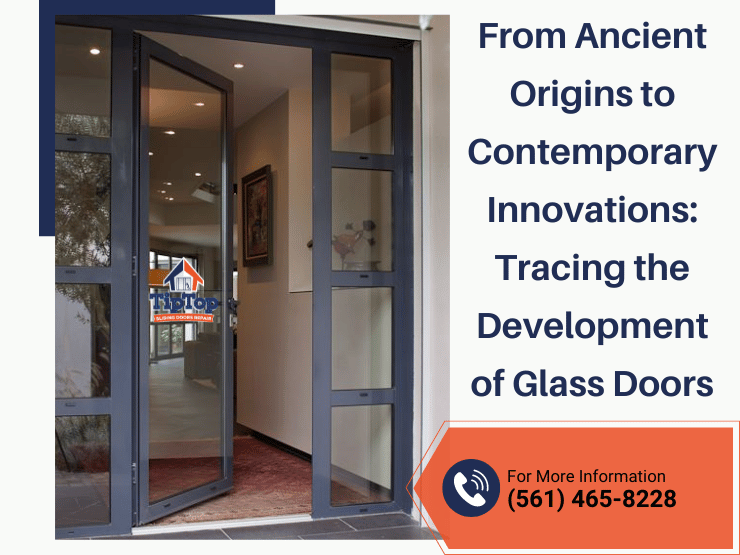
The Evolution of Glass Doors: A Journey from Antiquity to Modernity
By Tip Top Sliding Doors
Glass doors, a symbol of transparency and elegance, have journeyed through time, evolving from simple, rudimentary designs in antiquity to sophisticated, energy-efficient models in the modern era. This evolution mirrors advancements in technology, changes in architectural trends, and the shifting needs of society.
How have glass doors evolved over time?
Let’s embark on a historical journey to explore the transformation of glass doors from their inception to the present day. Follow along with our sliding doors repair company as we recount the history of glass doors.
Antiquity and the Middle Ages
The story of glass doors begins in ancient Rome, where the first known examples of clear glass windows were discovered. Although these were not doors, the technology laid the foundation for future glass applications in architectural elements. Romans mastered the art of glass-making, but it wasn’t until the Renaissance that glass was used more extensively in buildings, including doors, primarily in churches and the homes of the wealthy, showcasing the prestige and innovation of the era.
The Renaissance to the 19th Century
During the Renaissance, the use of glass in architecture became a symbol of wealth and sophistication. The development of clearer and more refined glass production techniques allowed for larger panes to be used in doors and windows. The Gothic Revival and Victorian eras saw the introduction of stained glass doors, which added color and artistry to buildings, reflecting the period’s appreciation for detailed craftsmanship.
20th Century: The Modern Movement
The 20th century marked a significant turning point in the evolution of glass doors, fueled by the Modernist movement. Architects like Mies van der Rohe and Philip Johnson experimented with glass’s aesthetic and functional qualities, emphasizing transparency and the blurring of indoor and outdoor spaces. The development of tempered and safety glass made large glass doors feasible and safe, leading to the popularization of sliding glass doors in homes and commercial buildings.
Towards Energy Efficiency and Sustainability
As environmental concerns became more prominent, the focus shifted towards energy efficiency and sustainability in the late 20th and early 21st centuries. Advances in double glazing, low-emission coatings, and thermal breaks allowed glass doors to retain indoor temperatures and reduce energy consumption. Today, smart glass technology, which can change transparency and insulate based on temperature, represents the cutting edge of glass door innovation, combining comfort, efficiency, and design.
Contemporary and Future Trends
In contemporary architecture, glass doors continue to evolve, featuring minimalist designs with hidden frames, pivot mechanisms, and integration with smart home systems for enhanced functionality and security. The future of glass doors lies in further technological advancements that promise even greater energy efficiency, durability, and integration with the natural environment, maintaining their timeless appeal while meeting modern demands.
Professional Glass Door Solutions
From the sand-swept workshops of ancient Rome to the sleek, energy-efficient homes of today, glass doors have undergone a remarkable evolution. They have transitioned from luxury items for the few to essential elements in modern architecture, celebrated for their ability to connect spaces and bring natural light into our homes and workplaces.
If you are in need of sliding glass door services, get in touch with Tip Top Sliding Doors. Our team provides the sliding door repair Boynton Beach believes in. As we look to the future, the evolution of glass doors promises to continue, guided by the principles of innovation, sustainability, and beauty.